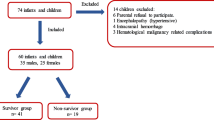Abstract
Objective
To estimate the incidence of reactive thrombocytosis among febrile young infants and to asses the utility of platelet count as a potential predictor of serious bacterial infection (SBI).
Design
Retrospective study between January 2005 and December 2008.
Setting
Tertiary care pediatric unit.
Participants
All infants 29 to 89 days of age, admitted with rectal temperature >38°C without a focus of infection.
Main Outcome Measures
The results of the sepsis evaluation on admission were recorded. SBI included all cases of occult bacteremia, urinary tract infection, bacterial meningitis, pneumonia, bacterial gastroenteritis and infections of the soft tissues and bones.
Results
Of the 408 infants studied, 103 (25.2%) had SBI. Platelet count was significantly higher in infants with SBI compared to those without (median 513000 /mm3 [interquartile range 455,000–598,000/mm3] vs median 398000/mm3; [interquartile range 313,000–463,000/mm3]; P<0.001). Thrombocytosis had only moderate ability in predicting SBI (area under the curve: 0.74, 95%CI 0.70–0.79). The combination of platelet count ≥450,000/mm3, WBC ≥15,000/mm3, C-reactive protein ≥2 mg/dL, and pyuria ≥10 WBC/hpf would lead to misclassification of 4 infants with SBI (3.9% of SBIs; negative likelihood ratio 0.08).
Conclusions
Reactive thrombocytosis was a frequent finding in young infants with SBI. Thrombocytosis ≥450,000 cells/mm3, in combination with leucocytosis, elevated CRP and pyuria, may help in early recognition of febrile young infants at risk for SBI.
Similar content being viewed by others
References
Slater M, Krug SE. Evaluation of the infant with fever without source: an evidence based approach. Emerg Med Clin North Am 1999;17:97–126.
Baraff LJ, Oslund SA, Schriger DL, Stephen ML. Probability of bacterial infections in febrile infants less than three months of age: a metaanalysis. Pediatr Infect Dis J 1992;11:257–264
Isaacman DJ, Shults J, Gross TK, Davis PH, Harper M. Predictors of bacteremia in febrile children 3 to 36 months of age. Pediatrics 2000; 106: 977–982.
Hsiao AL, Chen L, Baker MD. Incidence and predictors of serious bacterial infection among 57- to 180-day-old infants. Pediatrics 2006;117:1695–1701.
Baker MD, Avner JR, Bell LM. Failure of infant observation scales in detecting serious illness in febrile, 4- to 8- week-old infants. Pediatrics 1990;85:1040–1043.
Steere M, Sharieff GQ, Stenklyft PH. Fever in children less than 36 months of age — Questions and strategies for management in the emergency department. J Emerg Med 2003;25:149–157.
Ishimine P. Fever without source in Children 0 to 36 months of age. Pediatr Clin North Am 2006; 53: 167–194.
Baraff LJ, Bass JW, Fleisher GR, Klein JO, McCracken GH Jr, Powell KR, et al. Practice guideline for the management of infants and children 0 to 36 months of age with fever without a source. Pediatrics 1993;92:1–12.
Baskin MN, O’Rourke EJ, Fleisher GR. Outpatient treatment of febrile infants 28 to 89 days of age with intramuscular administration of ceftriaxone. J Pediatr 1992;120:22–27.
Baker MD, Bell LM, Avner JR. Outpatient management without antibiotics of fever in selected infants. N Engl J Med 1993;329:1437–1441.
Jaskiewicz JA, McCarthy CA, Richardson AC, White KC, Fisher DJ, Dagan R, et al. Febrile Infant Collaborative Study Group. Febrile infants at low risk for serious bacterial infection — an appraisal of the Rochester criteria and implications for management. Pediatrics 1994;94:390–396.
Bachur RG, Harper MB. Predictive model for serious bacterial infections among infants younger than 3 months of age. Pediatrics 2001;108:311–316.
Pulliam PN, Attia MW, Cronan KM. C-reactive protein in febrile children 1 to 36 months of age with clinically undetectable serious bacterial infection. Pediatrics 2001;108;1275–1279.
Galetto-Lacour A, Zamora SA, Gervaix A. Bedside procalcitonin and C-reactive protein tests in children with fever without localizing signs of infection seen in a referral center. Pediatrics 2003;112;1054–1060.
Mathew JL. Can CRP predict bacterial infection in children with fever? Indian Pediatr 2008;45:129–133.
Olaciregui I, Hernández U, Muñoz JA, Emparanza JI, Landa JJ. Markers that predict serious bacterial infection in infants under 3 months of age presenting with fever of unknown origin. Arch Dis Child 2009;94:501–505.
Hsiao AL, Baker MD. Fever in the new millennium: a review of recent studies of markers of serious bacterial infection in febrile children. Curr Opin Pediatr 2005;17:56–61.
Mantadakis E, Tsalkidis A, Chatzimichael A. Thrombocytosis in childhood. Indian Pediatr 2008;45:669–677.
Matsubara K, Fukaya T, Nigami H, Harigaya H, Hirata T, Nozaki H, et al. Age-dependent changes in the incidence and etiology of childhood thrombocytosis. Acta Haematol 2004;111:132–137.
Dame C, Sutor AH. Primary and secondary thrombocytosis in childhood. Br J Haematol 2005;129:165–177.
O’shea J, Sherlock M, Philip R. Thrombocytosis in childhood. Acta Haematol 2005;113:212.
Vlacha V, Feketea G. Thrombocytosis in pediatric patients is associated with severe lower respiratory tract inflammation. Arch Med Res 2006;37:755–759.
Dodig S, Raos M, Kovac K, Nogalo B, Benko B, Glojnaric I, et al. Thrombopoietin and interleukin-6 in children with pneumonia-associated thrombocytosis. Arch Med Res 2005;36:124–128.
Thomas GA, O’Brien RT. Thrombocytosis in children with Hemophilus influenzae meningitis. Clin Pediatr (Phila) 1986;25:610–611.
Garoufi A, Voutsioti K, Tsapra H, Karpathios T, Zeis PM. Reactive thrombocytosis in children with upper urinary tract infections. Acta Paediatr 2001;90:448–449.
Dharnidharka VR, Kandoth PW. Prevalence of bacteriuria in febrile infants. Indian Pediatr 1993;30:987–990.
Srivaths PR, Rath B, Prakash SK, Talukdar B. Usefulness of screening febrile infants for urinary tract infection. Indian Pediatr 1996;33:218–220.
Hoberman A, Wald ER. Urinary tract infections in young febrile children. Pediatr Infect Dis J 1997;16:11–17.
Bachur R, Perry H, Harper M. Occult pneumonias: empiric chest radiographs in febrile children with leukocytosis. Ann Emerg Med 1999;33:166–173.
Author information
Authors and Affiliations
Corresponding author
Rights and permissions
About this article
Cite this article
Fouzas, S., Mantagou, L., Skylogianni, E. et al. Reactive thrombocytosis in febrile young infants with serious bacterial infection. Indian Pediatr 47, 937–943 (2010). https://doi.org/10.1007/s13312-010-0158-3
Published:
Issue Date:
DOI: https://doi.org/10.1007/s13312-010-0158-3




